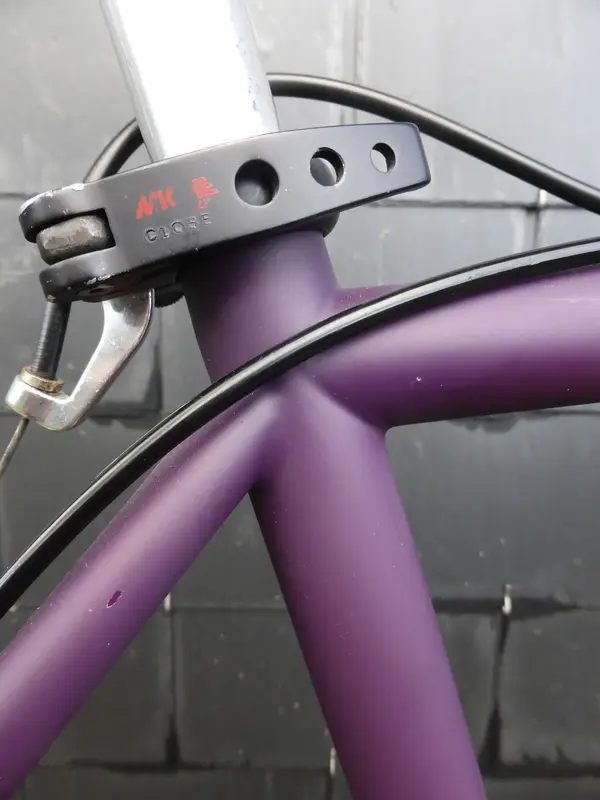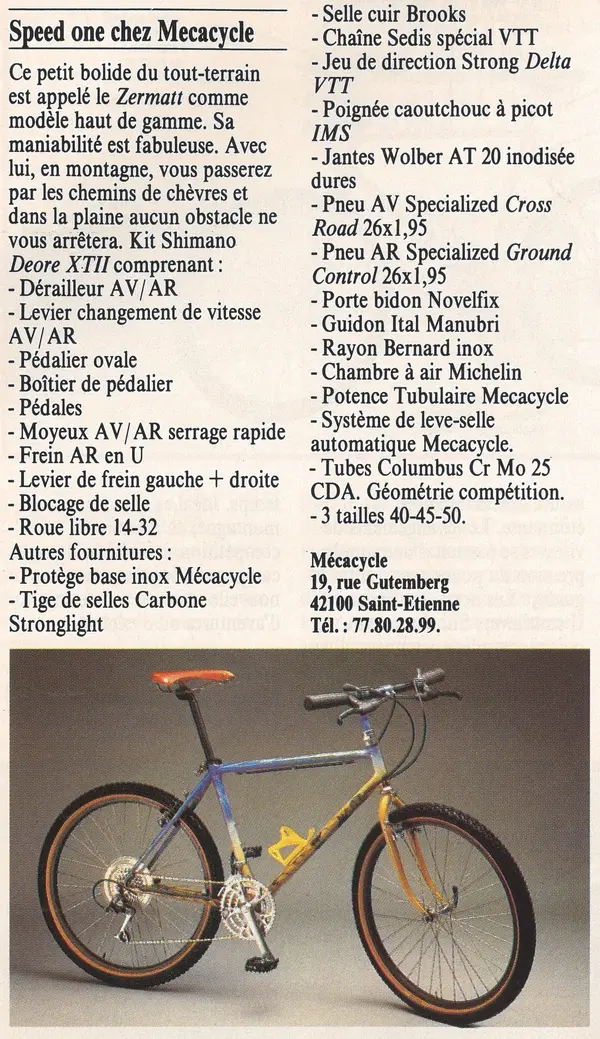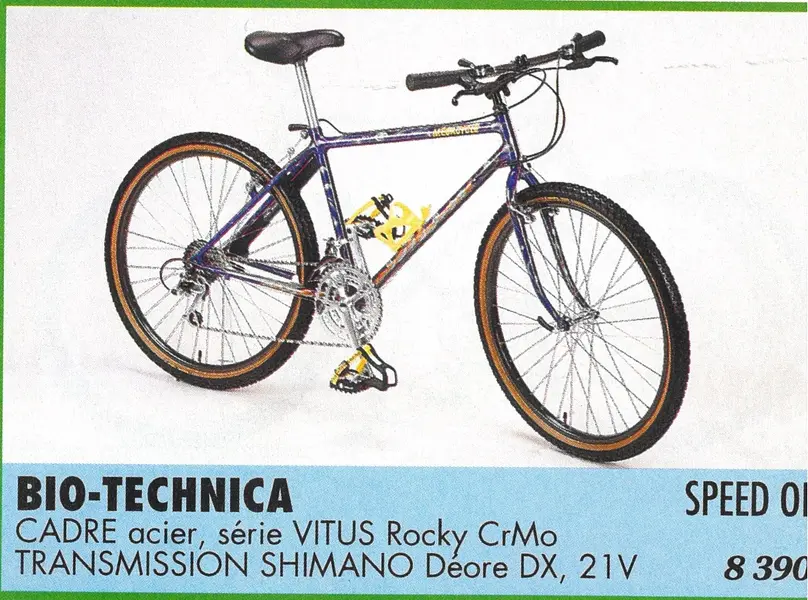Hi,
I'm currently working on an old (Bio-Technica era?) Mécacycle MTB from France. You already know it from this post. Fillet-brazed frame and forks, except for the lugged bottom bracket shell:

Unknown model and model year. The scarce photos of other Bio-Technica/Mécacycle MTBs show totally different beasts. From rare old French bike magazines, it could be the Zermatt model, but photographed evidences are lacking.
If it can help narrow down the year, rear axle spacing is 130mm, so 80ish. But sloping geometry, rear cantilever brake mounts (i.e. no U-brake mounts) and forward seat pinch are so 90ish. Surprisingly, no rear brake cable stop. At all. And with the forward seat pinch, you cannot attach any removable rear brake cable stop, as on my Peugeot Team Line 2000:

So, I don't know what were the brake options at the time (Magura Hydro Speed Mountain?). Oh, and while we're detailing the rear brake line, did you also noticed the strangely un-evenly spaced cable mounts on the top tube?
Anyway, here are the measurements that I took with a vernier caliper on the raw frame (it has been sanded so that the framebuilder could repair the dent in the seat tube I mentioned in the linked post at the beginning):
- top-tube: 28.6mm;
- down-tube: 31.7mm;
- seat tube: 28.6mm with ~31.2mm external/bulge-butting at the top. I wasn't able to properly determine the seatpost diameter but tube thickness is 2.5mm at the top. Hard to tell if the tube is butted;
- head tube: ~33.5mm O.D., 30.1mm I.D. (to accommodate for the 30.2mm lower cup of a standard 1" ISO headset), ~1.7mm thickness. Hard to tell if the tube is butted;
- steerer tube: standard 1" ISO, ~2.5mm thickness, 5 helicoidal reinforcements at the bottom. Hard to tell if the tube is butted.
Too difficult to take measurements of the seatstays and chainstays.
No stamp, no logo, no writing, no number (except for S/N 108 ), no other helical ridges elsewhere than the steerer tube, no nothing that could help identify the tubeset. With all that in mind and the above measurements, what tubeset could this Mécacycle be made of? From the mentioned old magazines, depending on the years, options for the Zermatt model range from Super Vitus 983 MB (standing for Mountain Bike), Vitus Rocky, Columbus OR or Columbus Cr Mo 25 CDA (don't know what the latter could be; CDA is probably a typo for CD4, so could be Cromor tubeset, but...).
Although the seat, head and steerer tubes have very distinctive traits, I wasn't able to find a matching tubeset with these traits/measurements. Did Vitus manufactured externally-butted seat tube, for example? This could quickly discard one candidate, as I know that Columbus did. Similarly, the 5 helicoidal reinforcements at the bottom of the steerer tube are also very characteristic. Unfortunately, both Vitus and Columbus have manufactured reinforced steerer tubes. Some say that 5 reinforcements is for Columbus whereas 6 is for Vitus but a post (that I can no more find again; grrrrr!) showed a Super Vitus 980 (road frame) steerer tube with 5 ridges too.
Any input/suggestion? Oh, and if you know for sure the model and model year of this Mécacycle, that would be great too .
.
Thanks!
I'm currently working on an old (Bio-Technica era?) Mécacycle MTB from France. You already know it from this post. Fillet-brazed frame and forks, except for the lugged bottom bracket shell:
Unknown model and model year. The scarce photos of other Bio-Technica/Mécacycle MTBs show totally different beasts. From rare old French bike magazines, it could be the Zermatt model, but photographed evidences are lacking.
If it can help narrow down the year, rear axle spacing is 130mm, so 80ish. But sloping geometry, rear cantilever brake mounts (i.e. no U-brake mounts) and forward seat pinch are so 90ish. Surprisingly, no rear brake cable stop. At all. And with the forward seat pinch, you cannot attach any removable rear brake cable stop, as on my Peugeot Team Line 2000:

So, I don't know what were the brake options at the time (Magura Hydro Speed Mountain?). Oh, and while we're detailing the rear brake line, did you also noticed the strangely un-evenly spaced cable mounts on the top tube?
Anyway, here are the measurements that I took with a vernier caliper on the raw frame (it has been sanded so that the framebuilder could repair the dent in the seat tube I mentioned in the linked post at the beginning):
- top-tube: 28.6mm;
- down-tube: 31.7mm;
- seat tube: 28.6mm with ~31.2mm external/bulge-butting at the top. I wasn't able to properly determine the seatpost diameter but tube thickness is 2.5mm at the top. Hard to tell if the tube is butted;
- head tube: ~33.5mm O.D., 30.1mm I.D. (to accommodate for the 30.2mm lower cup of a standard 1" ISO headset), ~1.7mm thickness. Hard to tell if the tube is butted;
- steerer tube: standard 1" ISO, ~2.5mm thickness, 5 helicoidal reinforcements at the bottom. Hard to tell if the tube is butted.
Too difficult to take measurements of the seatstays and chainstays.
No stamp, no logo, no writing, no number (except for S/N 108 ), no other helical ridges elsewhere than the steerer tube, no nothing that could help identify the tubeset. With all that in mind and the above measurements, what tubeset could this Mécacycle be made of? From the mentioned old magazines, depending on the years, options for the Zermatt model range from Super Vitus 983 MB (standing for Mountain Bike), Vitus Rocky, Columbus OR or Columbus Cr Mo 25 CDA (don't know what the latter could be; CDA is probably a typo for CD4, so could be Cromor tubeset, but...).
Although the seat, head and steerer tubes have very distinctive traits, I wasn't able to find a matching tubeset with these traits/measurements. Did Vitus manufactured externally-butted seat tube, for example? This could quickly discard one candidate, as I know that Columbus did. Similarly, the 5 helicoidal reinforcements at the bottom of the steerer tube are also very characteristic. Unfortunately, both Vitus and Columbus have manufactured reinforced steerer tubes. Some say that 5 reinforcements is for Columbus whereas 6 is for Vitus but a post (that I can no more find again; grrrrr!) showed a Super Vitus 980 (road frame) steerer tube with 5 ridges too.
Any input/suggestion? Oh, and if you know for sure the model and model year of this Mécacycle, that would be great too
Thanks!


